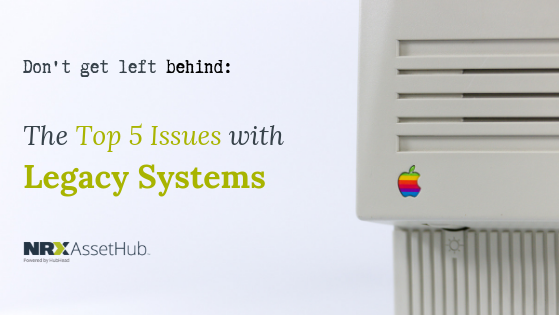When companies look to improve the quality of data in their CMMS system, one of the most common issues they face is with their assets that are tied up in legacy systems. It may seem easier to find a solution that will work with these systems, but as time goes on you gradually lose more and more ability to innovate and improve your operations. The cost of your legacy solution exceeds by orders of magnitude and many of the new innovative applications built on more efficient new platforms. Simply put, it’s not a long-term solution.
So why do companies hesitate to adopt more modern solutions? One of the key barriers is an IT organization that is more concerned with preserving their existing roles and is not trained in newer technologies, rather than adopt anything new they would prefer not to change.
Keeping your data in legacy systems may seem like a cheaper, cost-effective solution; but it’s more trouble than its worth. Here are the top 5 issues with legacy systems, and why you should make the switch.
Top 5 issues with Legacy Systems
1. They Impact Security Measures
Legacy systems may give the impression that they are more secure than modern alternatives due to being older and less attractive to exploit, but it’s that same assumption that makes them more vulnerable. Lack of support means fixes and patches may come late or not at all, leaving your data at risk of being tampered with or manipulated. The longer these systems are used, the more they become a danger to the company, rather than an asset.
2. They are expensive in the long-term
It seems almost counter-intuitive that an older software would cost more than a newer, more updated one. Looking simply at purchasing it, this is usually the case. However, the cost increases the longer it is used. Developers aren’t interested in supporting older systems, making them more expensive to update and maintain. The cost of hiring consultants to internally support your legacy systems is immense. By investing in an up-to-date software, you are ensuring that you have a product that is going to have full support, years down the line. Legacy systems often require expensive environments that are also expensive to maintain.
3. They widen the knowledge gap
As senior employees who have been experts in these systems, retire and pave the way for a newer workforce, they take their expertise and experience with them. Their successors are likely well-versed in modern programs, resulting in potentially large gaps in knowledge. Further knowledge gaps result from legacy data that is stored in excel files, paper files or even just “in one’s memory.” This could result in large decreases in productivity, dips in data accuracy and equipment failures. If legacy data isn’t migrated to more modern systems, it puts companies at a disadvantage, as their workforce is tasked with relearning older systems. They say you can’t teach an old dog new tricks, but why try and teach a new dog old ones?
4. They lack flexibility
Legacy systems often have limited functionality. The Industrial Internet of Things (IIoT) is progressing towards technology that focuses on day to day tasks. Systems need to be adaptable and adjustable in order to fit any business and industry. One of the main reasons why many companies use multiple legacy asset management systems is due to the lack of flexibility in their legacy systems. Having asset data stored in a modern solution results in less crossover, less confusion and easier management across the board.
5. Lack of Information
Many of these legacy systems lack the ability to provide information in real-time. Which is integral to almost any industry. Not having up-to-date information readily available prevents the ability to react or solve problems in a timely manner. Furthermore, some legacy systems may not have the capabilities to adequately provide enough details for your data, which may lead to issues over misinformation.
How Can NRX help?
NRX AssetHub provides maintenance and reliability professionals at asset-intensive businesses. With world-class software solutions for analyzing, visualizing, building, editing, organizing, approving, and sustaining high-quality Asset and Maintenance Data for the Enterprise Asset Management (EAM) and Computerized Maintenance Management (CMMS) systems. We help our customers get their CMMS data right. To learn more about how we can help with migrating your legacy data check out our data migration brochure or contact us at 1-877-603-4679
Share this article

